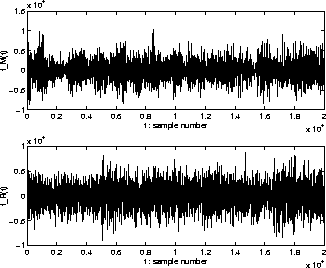


Next: About this document ...
Up: No Title
Previous: Appendix 1. Proof of
- Masashi Unoki was born in Akita, Japan on June 26, 1969.
He Graduated the School of Information Engineer, the Polytechnic
University in 1994.
He received master degree (Information Science) from Japan Advanced
Institute of Science and Technology (JAIST) in 1996.
Since April 1996, he has been an doctoral program in the School of
Information Science, Japan Advanced Institute of Science and
Technology.
His main research interests are in digital signal processing for
acoustic signals and modeling of the auditory system.
He is a member of the Institute of Electronics, Information and
Communication Engineers (IEICE) of Japan and the Acoustical Society of
Japan (ASJ).
- Masato Akagi was born in Okayama, Japan on September 12, 1956. He
received a B.E. degree from Nagoya Institute of Technology in 1979,
and M.E. and D.E. degrees from Tokyo Institute of Technology in 1981
and 1984, respectively. He joined the Electrical Communication
Laboratories, Nippon Telegraph and Telephone Corporation (NTT) in
1984. From 1986 to 1990, he worked at the ATR Auditory and Visual
Perception Research Laboratories. Since 1992, he has been with School
of Information Science, Japan Advanced Institute of Science and
Technology (JAIST) and now he is an Associate Professor of JAIST. His
research interests include speech perception, modeling of speech
perception mechanisms of humans, and signal processing
of speech. During 1988, he joined the Research Laboratories of
Electronics, MIT as a visiting researcher and in 1993, he studied at
the Institute of Phonetic Science, Univ. of Amsterdam. Dr. Akagi is a
member of the Institute of Electronics, Information and
Communication Engineers (IEICE) of Japan, the Acoustical Society of
Japan (ASJ), the Institute of Electrical and Electronic Engineering
(IEEE), the Acoustical Society of America (ASA), and the European
Speech Communication Association (ESCA).
Figure:
Wavelet analysis-system.
 |
Figure:
Impulse response and amplitude of gammatone filter (
f0=600[Hz], N=4, bf=22.9945).
 |
Figure:
Frequency characteristics of wavelet filterbank.
 |
Figure:
Characteristics of adjacent auditory filters.
 |
Figure:
Signal segregation algorithm.
![% latex2html id marker 1671
\fbox{\footnotesize{
\begin{minipage}[h]{7cm}
\begin...
...onstruct $\hat{f}_1(t)$\space and $\hat{f}_2(t)$ ;
\end{tabbing}\end{minipage}}}](img107.gif) |
Figure:
Acoustic signals:
f1(t), m=0, f21(t), and f22(t).
 |
Figure:
Noise-added signals: fM(t) and fR(t).
 |
Figure:
Amplitude envelope Sk(t) and output phase  (In
the case of noise-added signal fM(t)).
(In
the case of noise-added signal fM(t)).
 |
Figure:
dSk(t)/dt and
 (In the case of noise-added
signal fM(t)).
(In the case of noise-added
signal fM(t)).
 |
Figure:
Extracted result (In the case of noise-added signal fM(t)):
 and
and
 .
.
 |
Figure:
Relationship between bandwidth and masking release.
 |



Next: About this document ...
Up: No Title
Previous: Appendix 1. Proof of
Masashi Unoki
2000-10-26